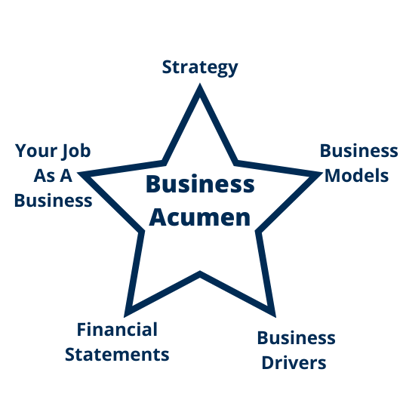Online Course:
Business Acumen for Marketing, Demand Generation & Sales
What’s Business Acumen?
It’s the ability to intuitively grasp the performance drivers for someone else's business – and then clearly explain how your product or service will drive THEIR results. It's an "ROI on the fly" conversation that's an equal mixture of business understanding, asking the right questions and pouncing on opportunity when it presents itself.
When your salespeople have business acumen – greater growth and bigger margins are yours for the taking. When they don’t – competition, commoditization and falling margins are your future.

Understanding Strategy
Strategy is one of the most commonly used words in business – and the least understood. Salespeople who understand strategy see opportunities to capture a sale and obstacles to avoid that others don’t. Salespeople who can discuss and support strategic conversations are welcomed to the executive suite in buyer organizations; salespeople who can’t are barred.
- What is strategy?
- The language of strategy.
- The difference between strategy and tactics.
- How strategy is developed – and changed.
- Talking about results.
Understanding Business Models
Companies have different ways in which they make money. The underlying process that drives profitability for a company is it’s business model. Salespeople must understand the basic way companies make money if they are to have any chance of positioning their offering as a true solution. While on first blush business models appear to be very complicated and unlimited, our research has enabled us to create The Five Core Business Models™. Once a salesperson understands which model a prospect or customer fits in, their ability to create value explodes.
- What is a business model?
- The Five Core Business Models™.
- The difference between products, services and manufacturing businesses.
- What equity value is, and how you create it.
Understanding Causes and Drivers of Results
Two critical skills for a B2B salesperson are: 1) diagnostic capabilities, and 2) the ability to monetize the value of an offering. In order to do that, salespeople must be able to trace symptoms backward to understand the causes of problems (rather than just immediately attempting to solve a problem); and they must be able to demonstrate how their offering impacts the downstream components of the business. This enables them to bypass selling merely on features and benefits (their commodities) and to become a problem remover.
- Identifying indicators.
- Wearing the hat of the executive.
- Understanding a company’s organization chart.
- How job descriptions impact the buy cycle.
- Diagnosing the problem.
- Establishing the cost of the problem.
Understanding Financial Statements
Financials are the vital signs for any business. Successful selling requires that salespeople translate the “features” and “benefits” of their offering to how it impacts a company’s financial statements. Additionally, financial statements (like vital signs) are critical clues in “worry list items” and “symptoms” of issues that can lead to successfully positioning your offerings.
- The income statement.
- The balance sheet.
- Financial Ratios.
- The difference between cash flow & profitability.
- Demonstrating Return on Investment (ROI).
- Building ROI Maps™.
Managing the Territory As a Business
Whenever salespeople present their company with an opportunity, costs are incurred. Running a sales territory is much like running a business. When the salesperson pursues an opportunity, they are “borrowing” resources from the “bank” (their selling company), and the “bank” has every reason to expect the “loan” will be repaid in the form of closed business. Too often, the effective management of resources is referred to as “time management.” While time management is important, it is not enough. Salespeople who understand their business – and run their territories as a business – produce 4 to 7 times the profit of others.
- Creating an effective opportunity filter/calculator.
- Identifying worry signs.
- Making ROI cases internally.
- Understanding pricing and margins.
- Leveraging efforts.
- 5 Sections | 16 Modules
- OnDemand Video Sessions
- Program Workbooks
- Job Aids
- Participation in special group AMAs
- Access to Lift's Coaching Team






